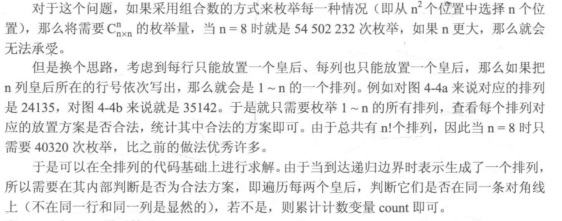一、问题:放苹果
题目描述
把M个同样的苹果放在N个同样的盘子里,允许有的盘子空着不放,问共有多少种不同的分法?(用K表示)5,1,1和1,5,1 是同一种分法。
输入
第一行是测试数据的数目t(0 <= t <= 20)。以下每行均包含二个整数M和N,以空格分开。1<=M,N<=10。
输出
对输入的每组数据M和N,用一行输出相应的K。
样例输入
2
6 3
7 2
样例输出
7
4
分析:

代码:
#include<iostream> #include<algorithm> #include<cstring> #include<map> #include<cmath> using namespace std; int divnum(int pg,int pz); int main(){ int t; cin>>t; getchar(); while(t--){ int pg,pz; cin>>pg>>pz; cout<<divnum(pg,pz)<<endl;; } return 0; } int divnum(int pg,int pz){ if(pg==0||pz==1){ return 1; } if(pz>pg){ return divnum(pg,pg); }else{ return divnum(pg,pz-1)+divnum(pg-pz,pz); } }
二、问题:N皇后
前提问题:全排列
分析:

代码:


N皇后问题:
你的任务是,对于给定的N,求出有多少种合法的放置方法。
Input:
共有若干行,每行一个正整数N≤10,表示棋盘和皇后的数量;如果N=0,表示结束。
Output:
共有若干行,每行一个正整数,表示对应输入行的皇后的不同放置数量。
Sample Input:
1 8 5 0
Sample Output
1 92 10



#include<iostream> #include<algorithm> #include<queue> #include<cstdio> #include<cstdlib> using namespace std; int n,p[100],ans[100],hashTable[100] = {false}; int ct; void generateP(int index){ if(index==n+1){ ct++; return; } for(int x=1;x<=n;x++){ if(hashTable[x]==false){ bool flag = true; for(int pre=1;pre<index;pre++){ if(abs(index-pre)==abs(x-p[pre])){ flag = false; break; } } if(flag){ p[index] = x; hashTable[x] = true; generateP(index+1); hashTable[x] = false; } } } } int main(){ for(int i=1;i<=10;i++){ ct = 0; n = i; generateP(1); ans[i] = ct; } int t; while(cin>>t){ if(t==0){ break; } cout<<ans[t]<<endl; } return 0; }
三、问题:Prime Ring Problem
Note: the number of first circle should always be 1.
Input:n (0 < n < 20).
Output:
The output format is shown as sample below. Each row represents a series of circle numbers in the ring beginning from 1 clockwisely and anticlockwisely. The order of numbers must satisfy the above requirements. Print solutions in lexicographical order.
You are to write a program that completes above process.
Print a blank line after each case.
Sample Input:
6 8
Sample Output:
Case 1: 1 4 3 2 5 6 1 6 5 2 3 4 Case 2: 1 2 3 8 5 6 7 4 1 2 5 8 3 4 7 6 1 4 7 6 5 8 3 2 1 6 7 4 3 8 5 2
代码:
#include<iostream> #include<algorithm> #include<queue> #include<string> #include<cstdio> #include<stack> #include<list> #include<cmath> #include<cstring> #include<cstdlib> using namespace std; int n,a[30],vis[30]; int prime[40]={0,1,1,1,0,1,0,1,0,0,0,1,0,1,0,0,0,1,0,1,0,0,0,1,0,0,0,0,0,1,0,1,0,0,0,0,0,1,0,0}; void dfs(int num){ if(num==n&&prime[a[num-1]+a[0]]){ for(int i=0;i<num-1;i++){ printf("%d ",a[i]); } cout<<a[num-1]<<endl; }else{ for(int i=2;i<=n;i++){ if(vis[i]==0&&prime[i+a[num-1]]){ vis[i] = 1; a[num++] = i; dfs(num); vis[i] = 0; num--; } } } }; int main(){ int nu = 0; while(cin>>n){ memset(vis,0,sizeof(vis)); nu++; printf("Case %d:\n",nu); a[0]=1; dfs(1); printf("\n"); } system("pause"); return 0; }






【推荐】国内首个AI IDE,深度理解中文开发场景,立即下载体验Trae
【推荐】编程新体验,更懂你的AI,立即体验豆包MarsCode编程助手
【推荐】抖音旗下AI助手豆包,你的智能百科全书,全免费不限次数
【推荐】轻量又高性能的 SSH 工具 IShell:AI 加持,快人一步
· 10年+ .NET Coder 心语,封装的思维:从隐藏、稳定开始理解其本质意义
· .NET Core 中如何实现缓存的预热?
· 从 HTTP 原因短语缺失研究 HTTP/2 和 HTTP/3 的设计差异
· AI与.NET技术实操系列:向量存储与相似性搜索在 .NET 中的实现
· 基于Microsoft.Extensions.AI核心库实现RAG应用
· 10年+ .NET Coder 心语 ── 封装的思维:从隐藏、稳定开始理解其本质意义
· 【设计模式】告别冗长if-else语句:使用策略模式优化代码结构
· 提示词工程——AI应用必不可少的技术
· 字符编码:从基础到乱码解决
· 地球OL攻略 —— 某应届生求职总结